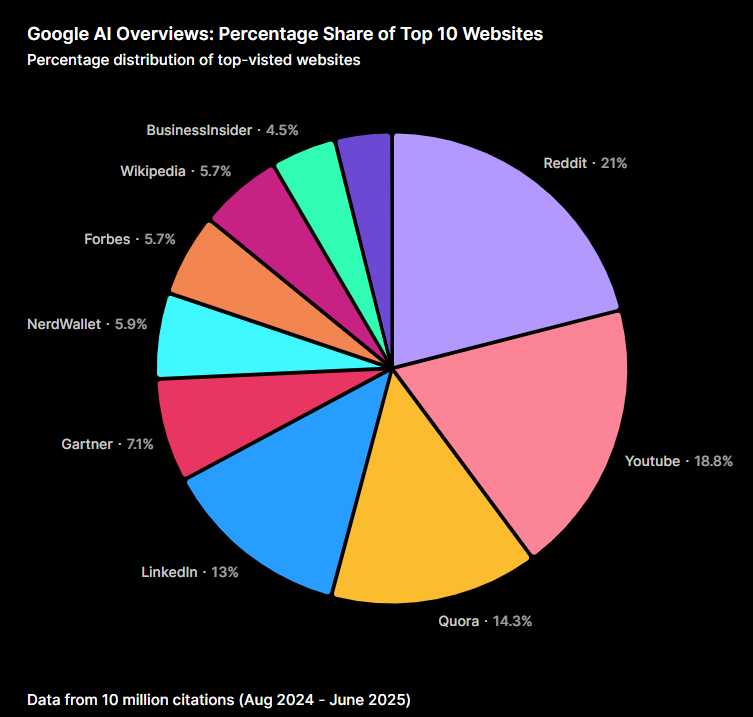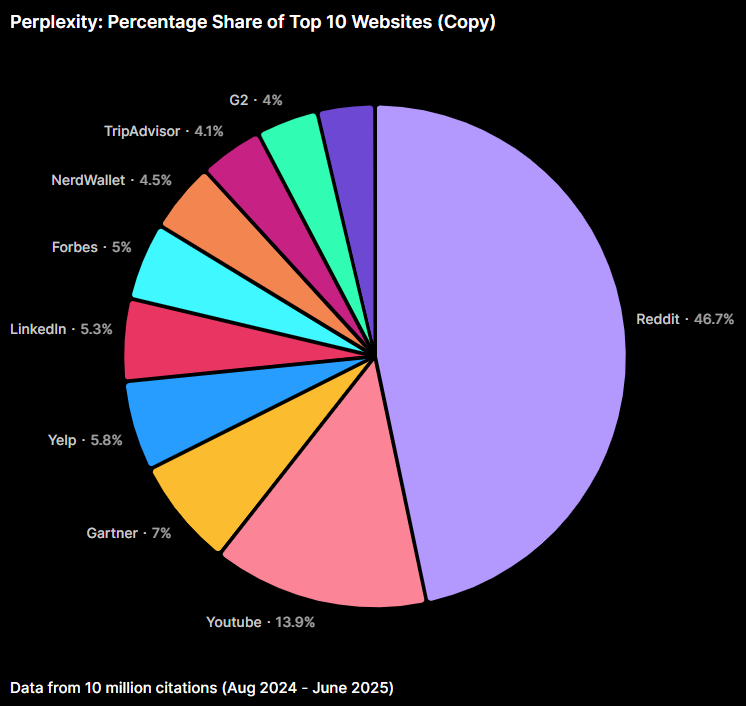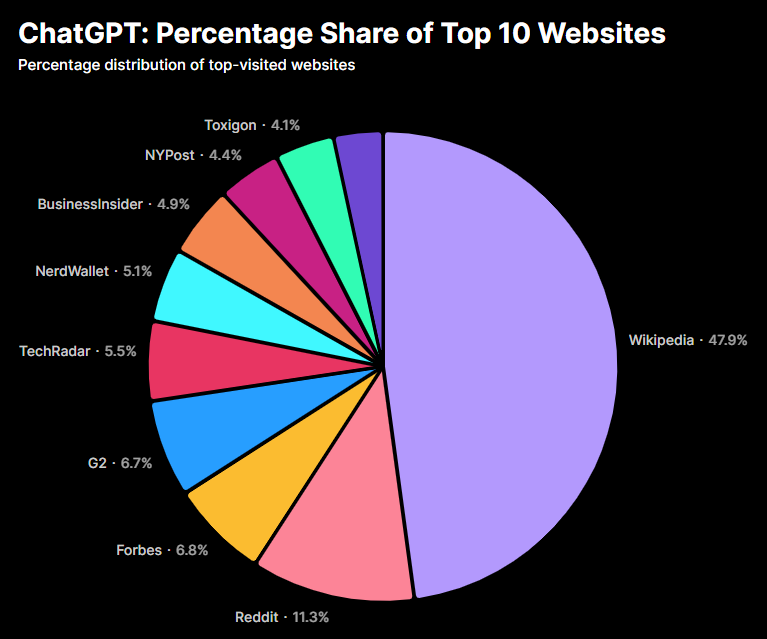From AI Mode rolling out to changes in ad platform policy, it’s been a busy fortnight in search.
To help you prioritise, we’ve colour coded updates to indicate importance:
🔴 Major developments likely to impact strategy
🟡 Worth watching or understanding
🟢 Informative, but lower impact for most
Here’s what marketers need to know.
Google Search
AI Mode gets full release in US 🔴
On June 12, Google launched the rollout of AI Mode in the US. This follows a long stint testing in Search labs, and a brief period of broader testing among a limited number of US users.
AI Mode is now available to all US users, even those who are not signed in or those using incognito mode. Data from AI Mode clicks has now begun filtering into Search Console. Although - as expected - this data is lumped into the standard web search data.
For marketers…
If you have a presence in the US, we recommend monitoring Search Console meticulously for at least a few months. The goal is to ascertain the impact of AI Mode on your traffic, both initially and over a longer period — once AI Mode use rate begins to stabilise.
Importantly, though, standard reporting won’t tell the full story. Since AI Mode clicks are currently lumped into standard web data in Search Console, identifying specific cause-and-effect may require deeper analysis and pattern-spotting.
For UK brands, pay close attention to the US rollout! The insights you can extract from AI Mode’s impact across the pond can be crucial in helping you prepare for the UK launch.
AI Mode to be integrated into main Google Search experience 🔴
In an interview with Lex Friedman, Google CEO Sundar Pichai confirmed the suspicions of most that AI Mode will be incorporated into Google's primary search page.
Google spokespeople have been saying for a while that AI Mode is the future of Google Search, but, in this interview, Pichai discusses the actual plan in brief when asked about the subject directly by Fridman:
Fridman: “Do you see a trajectory in the possible future where AI Mode completely replaces the 10 blue links plus AI Overview?”
Pichai: ‘Our current plan is AI Mode is going to be there as a separate tab for people who really want to experience that, but it’s not yet at the level where our main search page is. But as features work, we’ll keep migrating it to the main page.
‘And so you can think of it as a continuum. AI Mode will offer you the bleeding edge experience, but things that work will keep overflowing to AI Overviews and the main experience.’
For marketers…
While this is no doubt concerning to many, the gradualness of the process outlined by Pichai is encouraging. It suggests Google are going to try and smooth out any changes to limit impact and give marketers time to prepare.
Change may equal challenge, but it also equals opportunity. Contact TDMP to discuss how we can help your brand build visibility in AI outputs.
Study reveals most referenced sources in AI Overviews 🔴
A study on the citation patterns of AI search tools/features, published by Profound, revealed AI Overviews’ primary sources. With a 21% citation share, Reddit emerges as the favourite source, followed closely by YouTube (18.8%).

Source: Tryprofound
Perplexity takes this Reddit love even further, giving the forum-based social platform 46.7% of the citation share.

Source: Tryprofound
By contrast, ChatGPT massively favours Wikipedia as a source, with a citation share of 47.9%.

Source: Tryprofound
For marketers…
This is an incredibly valuable study that tells us several important things about how AI search platforms select source material.
Chiefly, it shows us just how different these tools are — and therefore how complex optimising for visibility in AI outputs is becoming.
Honing in on the findings for each platform, we get the following insights:
AI Overviews
- Prefers user-generated content (UGC) platforms
- Often prioritises content from formal sources where applicable, i.e. LinkedIn and Gartner
- Deeply ingrained in the Google ecosystem
Actionable takeaway: Strengthen your presence across both UGC and authoritative platforms. Encourage positive discussions and answers on forums like Reddit and Quora, while also investing in thought leadership on formal platforms like LinkedIn.
Ensure your content is technically sound, well-structured, and easily crawlable — Google’s AI Overviews favour content that aligns with existing knowledge graphs and trusted sources within its ecosystem.
ChatGPT
- Prioritises looking where the searcher would realistically look if they were using traditional search, e.g. Wikipedia
- Pulls from a varied source of traditional media, with a reasonable focus on tech-oriented sources
- Business and finance sites get a fair shake where relevant
Actionable takeaway: Keep your brand’s Wiki up to date and accurate. If your brand doesn’t have a Wikipedia page, try drafting and submitting one.
Granted, this may be easier said than done, as Wikipedia often rejects submitted pages and doesn’t give much of an explanation why.
Perplexity
- Huge reliance on community-led discussion sites
- Gives more room to review sites — again showing a preference for UGC
- Balances formal and consumer-focused sources well
Actionable takeaway: Engage actively on community-driven platforms like Reddit, Stack Exchange, and Quora, and encourage satisfied users to leave reviews on third-party sites. Building a strong, authentic presence across these channels increases the chances your brand will be cited or referenced in Perplexity’s results.
Also, monitor mentions on forums and review sites — they may influence how your brand is represented in AI-driven summaries.
Optimising for visibility in AI responses is a key aspect of TDMP’s SEO strategies. Learn more about our approach.
Google offers buyout option for employers 🟢
It seems the search industry titans are again looking to downsize their workforce, offering a buyout programme for current employees who:
‘... don’t feel aligned with our strategy, don’t feel energised by your work, or are having difficulty meeting the expectations of your role.’
This comes after a voluntary exit programme for US Googlers introduced earlier this year, and the laying off of 12,000 employees from various locations back in 2023.
The new exit programme has been offered to several departments across the company’s ads and search divisions. This includes the knowledge and Information teams, the Central Engineering teams, and the Marketing, Research, and Communications teams.
Coverage in the Wall Street Journal suggests that the cuts are being made as part of ‘steps … made to help fund billions in AI spending.’
How many employees Google is hoping to downsize by is currently unknown.
Google SEO
Google retires 7 structured data markups 🟡
Google is no longer considering the following markups when assembling rich results on SERPs:
- Book Actions: Enables rich results that lets users take direct actions (like buying or borrowing a book) from the SERP.
- Course Info: Helps educational providers show course details (like provider, title, and description) in enhanced search listings.
- Claim Review: Used by publishers and fact-checking sites to display verdicts (true/false) on claims directly in results.
- Estimated Salary: Allowed job listings to show average salary ranges in search.
- Learning Video: Marked videos as educational, often surfacing them in enriched formats.
- Special Announcement: A schema created for timely updates during crises like COVID-19.
- Vehicle Listing: Used to show detailed car listings in structured, shoppable formats.
Announced on their Search Central blog, Google suggests this mass deprecation is to ‘simplify the search results page’, claiming:
‘...our analysis shows that they’re not commonly used in Search, and we found that these specific displays are no longer providing significant value for users.
For marketers…
The first thing to note here is that this update isn’t going to affect how your pages are ranked. It does, however, mean that the visual enhancements specific to these markups will no longer appear on the SERPs, which could result in a slight downturn in clicks.
To offset this, you’ll need to compete more aggressively in standard search results and explore optimisation for AI-driven outputs.
Find out where to focus your SEO efforts with our guide: SEO in 2025: What’s changing - and what no longer matters
Importantly, there is no need to strip the now deprecated structured data from your site. Your pages won’t be penalised in any way — and other search engines may support these markups for some time.
Google fine with pages translated by AI 🟢
Google has recognised the progress made in the field of AI translation, reporting that it’s fine to translate using AI so long as the translations are accurate and provide value to users.
The following paragraph has since been removed from their Managing multi-regional and multilingual sites documentation:

Source: Search Engine Roundtable
For marketers…
If you have a multilingual site, you can now use AI to streamline the publishing of content in different languages without concern — as long as you use a reputable service.
However, we recommend having all AI translations thoroughly proofed before they go live.
ChatGPT
Better attribution for ChatGPT engagement 🔴
On June 16th, it was reported that OpenAI had updated the UTM parameters in ChatGPT to improve click transparency.
Now, all links collected in the ‘More’ section contain the new tracking parameters. Previously, only clicks on primary citations were trackable.
While a little slow to implement what seems like a no-brainer improvement, this shows that OpenAI understands the importance of being important to SEOs and site owners.
For marketers…
By expanding UTM parameters to include all outbound links in the 'More' section—not just primary citations—OpenAI is giving site owners greater visibility into how and when their content is being surfaced within ChatGPT.
For SEOs and publishers, this means:
- Clearer attribution in analytics tools like GA4, making it easier to quantify the impact of AI-driven discovery.
- Improved reporting on referral traffic from ChatGPT, helping validate the value of being included as a source.
- More incentive to optimise content that aligns with how ChatGPT aggregates and references information.
If you're not already tracking UTM-rich traffic from ChatGPT, now is a good time to ensure your analytics setup can surface these insights.
ChatGPT Search gets a tune-up 🔴
OpenAI also recently upgraded ChatGPT Search, announcing that the latest update would result in:
- ‘Smarter responses that are more intelligent, are better at understanding what you’re asking, and provide more comprehensive answers.
- ‘Better intelligence in longer conversations.
- ‘More robust availability to follow instructions, especially in longer conversations, significantly reducing repetitive responses.
- ‘Capability to run multiple searches automatically for complex or difficult questions.
- ‘Search the web using an image you’ve uploaded.’
The AI innovators also warned of the following ‘known limitations’ of the new iteration:
- ‘Users may notice longer responses with this new search experience.
- ‘In some cases a “chain of thought” reasoning will show up unexpectedly for simple queries. A fix for this is rolling out to users shortly.
- ‘ChatGPT may still make occasional mistakes — please double check responses.’
For marketers…
This upgrade may steadily increase ChatGPT Search’s user base: As adoption grows, getting cited or linked in outputs becomes a valuable source of exposure.
The noted updates also provide clues into the kind of content that gets surfaced in outputs:
Now ChatGPT Search has better understanding of user intent, richer follow-ups, and can better handle complex queries, you should prioritise:
- Publishing content that directly matches searcher intent - this has been essential for a long time, but it's especially important now AI engines can match intent better than search engines.
- Using clear, structured answers that AI can extract and cite effectively.
Considering the multimodal update (search with multiple types of input, i.e. text, image, etc), rich media may start to factor more over time.
Paid media
Google updates Account Pause Policy 🟡
Individual Google Ads accounts can now be paused if linked to a Manager account in violation of the third-party policy.
For the uninitiated, Google’s third-party policy applies to agencies, freelancers, and other partners who manage Google Ads on behalf of clients. It sets rules for how these third parties must operate, including:
- Transparency: Agencies must clearly disclose that they're managing Google Ads on a client’s behalf.
- Reporting: They must provide clients with regular, accurate performance reports.
- Honesty in pricing: They can't misrepresent how much of the client’s spend actually goes to Google Ads.
- Compliance: They must follow all Google Ads policies themselves and ensure their clients do too.
For advertisers…
If your Individual account gets paused due to this policy update, you’ll be notified via an in-account notification.
Ideally, your first move should be to resolve the underlying third-party issue with the Manager account. But if that’s going to be a longer job, unlinking your accounts is a quick fix.
Need help navigating policy changes or getting the most from your paid media? TDMP is a Google Premier Partner PPC agency with a proven track record of delivering data-driven campaigns that maximise your ROI. Learn more.
Microsoft Advertising introduces custom report builder 🟢
Microsoft Advertising has introduced several enhancements in its June platform update, led by the launch of a very much overdue Custom Report Builder.
Another key development is that Performance Max & Standard Shopping campaigns now compete fairly based on Ad Rank, rather than PMax campaigns being favoured by default.
For advertisers…
The Custom Report Builder is a decent quality-of-life update for Microsoft Ads users — especially those who’ve been missing easier, in-platform reporting like Google Ads has offered for years.
On the PMax vs Shopping campaign competition front, keep a close eye on shifts in impressions and conversions, and consider reallocating budget based on what’s actually performing best under the new rules.
Want to know how Microsoft Advertising compares with Google Ads? Read our guide: Microsoft vs Google Ads: Which is best for your brand?
Stay current with TDMP
That’s it for this round of updates. Stay tuned for our June-end roundup.
Need tailored advice on how these changes could impact your brand? Let’s talk.

